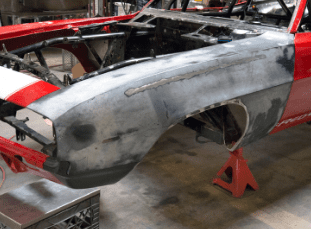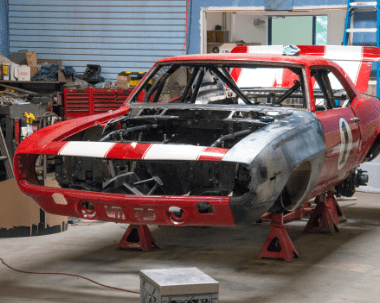FENDERS

One of the original build requirements set forth by Dan and RJ was to keep the car as original or factory-equipped as possible…within reason. The body has been no exception to this rule. Big Red wouldn’t be the icon it is if it had fiberglass fenders and doors. Steel is real!
The team was on the same page when it came to the fenders on Big Red. They had to be steel and they had to be original stampings. The last driver’s-side fender was a reproduction piece that was installed after a fight with a safety barrier in 2014 when Big Red was at a Hot Rod magazine shoot at Barber Motorsports Park in Alabama. Dave was never happy with the fitment. Even the best reproduction parts in the business require a little attention. No better time than the present to find a factory fender. Modified fenders like the ones on Big Red require extra effort.
Dave had trimmed some of the factory inner support structure out of the newly purchased vintage Chevrolet fender to reduce weight and give extra clearance for the suspension travel. He left enough to keep the rigidity of the mounting points to
the firewall and cowl, as well as a place to mount a factory hood hinge, but trimming leaves the fender a little flimsy overall. Rick Wymer fabricated a sheetmetal panel that attaches the engine compartment side edge to the outer panel. This panel increases the rigidity of the steel fender and also acts as a wheel well to protect the fender from getting dented by flying rocks coming off the sticky tires.
Dave shows RJ how the newly acquired and modified fender fits after he worked his magic on it. In the background, (left to right) Tim, Dan, and Shawn discuss other modifications slated for Big Red during the rebuild. The body/chassis have returned from the media blaster and are waiting their turn to go the body shop for body and paint work.
Big Red’s new fender is all ready to go. You’ll notice that there are some welding marks around the lips of the wheelwell where Dave welded in 1/4-inch steel tubing and then rolled the lip edges around. This is the best way to strengthen a lip that otherwise would be weak and eventually crack from constant flexing. The smooth, rolled lip also eliminates sharp edges that could slice the tire. The photo of the inside of the passenger-side fender shows the sealed inner aluminum panel to keep the El Mirage dust out of the cabin. This is one of many attempts made to limit “dusting.” The finished fender shows the cleanly rolled lip and how the fender roll is a little more pronounced at the bottom where it bolts to the body for additional strength.
